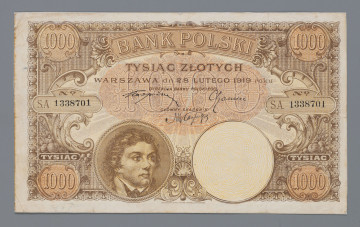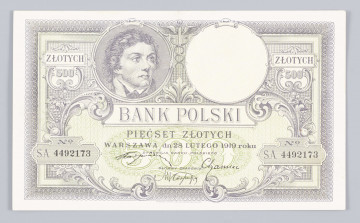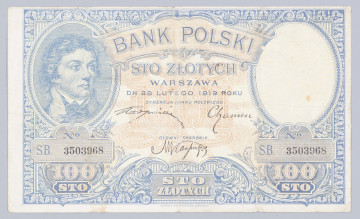
1000 zlotys
1919
National Museum in Lublin
Part of the collection: Paper money during the Second Polish Republic
The 1 and 2-zloty banknotes, bearing the date of issue of 28 February 1919 on the obverse, reflect the difficulties and vicissitudes of the early years of the Second Republic like no other. They belonged to a series of banknotes which, soon after regaining independence, were to replace the paper money of the previous Partitioners in circulation. The perturbations over the introduction of new banknotes started when the name of the currency to be used in Poland was being discussed. Of the various proposals, including ‘lech’, ‘sarmat’, ‘piast’, ‘polon’ and ‘zlotys’, the first and the last enjoyed the most support. Initially, the name lech won, but eventually the Sejm, by the Act of 28 February 1919 on the name of the Polish coin, decided in the first article: ‘The Polish monetary unit shall be called 'zloty', the hundredth part of which shall be called 'grosz'‘. At the same time, in the next article, the Act repealed the decree of the Head of State Józef Piłsudski of 5 February 1919 introducing the currency called lech in the Polish lands. The passing of the Act resulted in the beginning of efforts to introduce the zloty into circulation. The entity supervising this process was the Polish National Loan Fund (PKKP), an institution established by the German occupation authorities on 9th December 1916. In the case of banknotes, a decision was made to print them abroad. The lower denominations – from 1 to 50 zlotys – were produced in the printing house of the Bank of France. The printing of denominations from 100 to 5,000 zlotys was entrusted to Waterlow & Sons in London. Although, in 1919, the only issuing institution was the above-mentioned PKKP, the name Bank Polski appeared on the obverse of all the banknotes. In fact, this institution was established only on 15 April 1924, as one of the elements of Władysław Grabski's reform. In the case of the one- and two-zloty banknotes, the last element of their confusing history was their introduction into circulation not by the newly established Bank of Poland but by the Minister of Treasury. They were also never intended to be banknotes, only pass tickets. 100,000,000 pieces of one-zloty coins and 40,600,000 two-zloty coins were in circulation as substitute money until 30 September 1925. The definitive end to the complicated story came on 31 December 1926, when the final date for their redemption expired.
Leszek Poniewozik
Author / creator
Dimensions
cały obiekt: height: 92 mm, width: 63 mm
Object type
paper money
Technique
Material
paper
Creation time / dating
Creation / finding place
Owner
The National Museum in Lublin
Identification number
Location / status

1919
National Museum in Lublin

1919
National Museum in Lublin

1919
National Museum in Lublin
DISCOVER this TOPIC
Museum of King Jan III's Palace at Wilanów
DISCOVER this PATH
Educational path